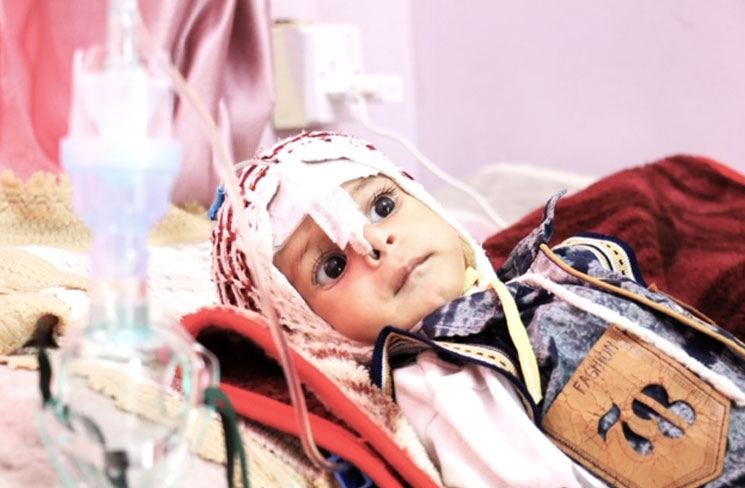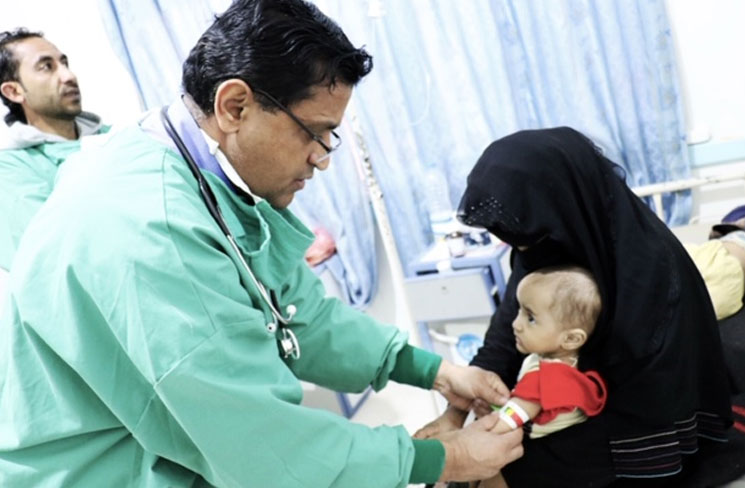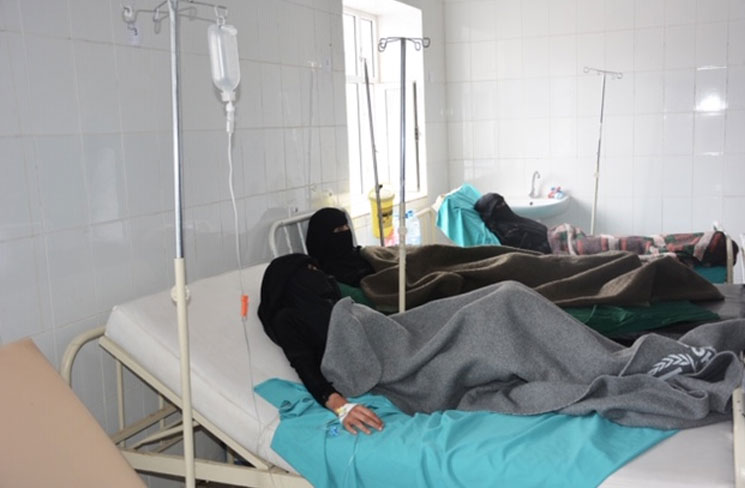 27 December 2018 ─ Al Sabeen Hospital in Sana’a has admitted many cholera patients over the last 2 years, including infants as young as 2 months. Many of them also suffer from acute malnutrition. At the peak of the cholera outbreak more than 150 patients a day were being admitted to Al Sabeen hospital with severe watery diarrhoea. Some 20% of the total were diagnosed with cholera.
27 December 2018 ─ Al Sabeen Hospital in Sana’a has admitted many cholera patients over the last 2 years, including infants as young as 2 months. Many of them also suffer from acute malnutrition. At the peak of the cholera outbreak more than 150 patients a day were being admitted to Al Sabeen hospital with severe watery diarrhoea. Some 20% of the total were diagnosed with cholera.
Two-and-a-half-year-old Ramez and eight-month-old Mohamed are brothers. Small and frail, they have been diagnosed with cholera and are moderately malnourished.
Their family moved from Hajjah to Sana’a after their father lost his job.
 “In Hajjah we used to drink pure water from wells,” says the boys’ mother, “but after moving to Sana’a we had to drink from water trucks.”
“In Hajjah we used to drink pure water from wells,” says the boys’ mother, “but after moving to Sana’a we had to drink from water trucks.”
It is almost 4 years since war erupted in Yemen, with devastating consequences for the country’s infrastructure and health system.
Despite ongoing humanitarian food assistance the latest IPC analysis - covering December 2018 to January 2019 - revealed 15.9 million people (53% of the population) faced food shortages. Of these, 17% of the population - about 5 million people - are classified as IPC Phase 4 (Emergency), and 36% - 10.8 million people - as IPC Phase 3 (Crisis).
Like millions of Yemenis, Ramez and Mohammed’s parents face a constant struggle to access healthcare, pay rent and feed their children.
“I have 3 more children. Their father is looking after them at home,” says the boys’ mother.
Within minutes she receives a phone call from her husband who tells her the children at home are starting to show signs of infection. They agree he should bring them to the hospital straight away.
Abdulmajeed Yahya is 8-months-old and weighs a little over 3 kilograms. He has been severely malnourished for over a month. He was diagnosed with cholera at Al Sabeen Hospital seven days ago, after making the 5 hour journey to Sana’a from Al Haymaharea with his mother and father.
“My husband lost his job after the war started and is now unemployed. We had to borrow money so we could come here from Al Haymaharea,” says Abdulmajeed’s mother.
 Sana’a’s 22 May Hospital treats many internally displaced families. It, too, sees large numbers of patients with symptoms of cholera and children suffering medical complications as a result of malnutrition.
Sana’a’s 22 May Hospital treats many internally displaced families. It, too, sees large numbers of patients with symptoms of cholera and children suffering medical complications as a result of malnutrition.
“We see two new patients suffering from cholera and malnutrition a day, many of them from families who own close to nothing. The hospital cannot accommodate in-patients so cases suffering from severe acute malnutrition with medical complications have to be referred to other hospitals,” says Suha Abdeen, a nurse on the hospital’s nutrition ward.
Jameel Moanis is 12-months-old and weighs just 3 kilograms. He was brought to 22 May Hospital a few days ago from Al Hudaydah and had to be referred to another hospital for more specialized treatment.
To help severely malnourished children suffering from medical complications WHO supports 269 health facilities in Yemen and has established 51 therapeutic feeding centres in 17 governorates. WHO has also established 72 diarrhoeal treatment centres and 25 oral rehydration centres for the treatment of cholera and other diarrhoeal diseases.
WHO works closely with the Ministry of Health and WASH cluster partners to contain cholera outbreaks, offering technical and logistical support to strengthen disease surveillance, assist diarrhoeal treatment and oral rehydration centres, train health workers on case management, deploy rapid response teams and improve sanitation and access to safe water.
There have been 280 198 suspected cases of cholera since the beginning of 2018, and 372 associated deaths. Children under 5 account fort 32% of the total suspected cases. Cholera has been reported in 22 out of Yemen’s 23 governorates, and 306 out of the country’s 333 districts.



